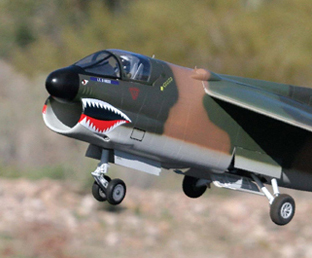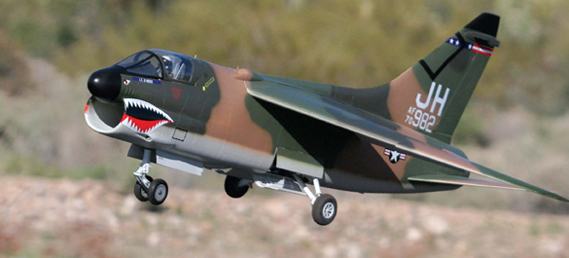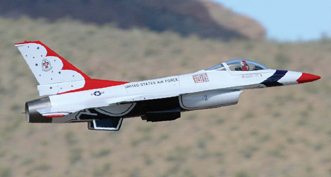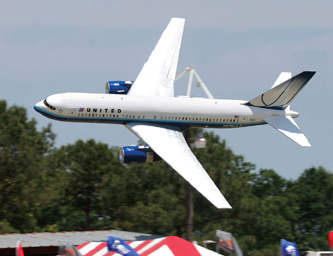Text and photos by John Reid
Electric jets can be as large and detailed as full turbine aircraft like this A-7 Corsair II. With the right motor combination, this aircraft will go over 160mph with turbine- like performance.
ONE OF THE HOTTEST ADVANCEMENTS in the world of RC has to go to the new generation of ducted-fan units. With the proliferation of high-quality and high-power brushless motors in the marketplace right now, it’s very easy to produce outstanding thrust from ducted-fan units. Just a few years back, they were reserved for smaller park-flying foamies. Today, they’ve made the leap to larger-size aircraft that come close to true ducted-fan units. Many pilots are opting for electric ducted fans over true turbine jets mainly because of the lower cost, ease of maintenance and in some cases, noise restrictions.
But what are some of the things a neophyte should consider when getting into the world of larger electric ducted fans? Let’s take a look at what to consider when making the move to electric jets.
IF YOU WANT TO GO FAST AND LARGE, THESE ARE THE PLANES YOU’LL BE LOOKING AT
FIRST THING FIRST, THE AIRCRAFT
The marketplace has many different jet aircrafts available, and they’re constructed from a wide array of materials.
- Foam: These generally have the lowest price and offer quick assembly and fast repairs. Many of them come with the ducted-fan unit and are the smaller size. While these planes will give you a speed thrill, if you latch onto a powerful motor and fan unit, they’ll most likely require some reinforcements. The thing to watch out for on these planes is that they have plenty of airflow through the body to keep everything cool, not just ducting for the fan unit alone. Remember, you have to keep the battery, ESC and motor cool.
- Balsa/plywood: These planes can measure from small to a much larger size than foam and prices range from inexpensive to somewhat pricey. The lightweight construction is a plus, but many times will also need some modifications to handle the stronger motor/fan units out there today. Repairs will take a little longer than foam, but once done, they can be made to look like new. You’ll most likely have to make some type of hatch for easy battery access.
- Fiberglass/balsa/plywood: These planes will also be available in the small to larger sizes and price points can range from inexpensive to somewhat pricey. Most will have a fiberglass body with wood wings and tail feathers. Damage to the body will require a little more skill to repair, but can be done by any modeler with an average shop. Most have some type of hatch access that makes battery changing easy.
- Fiberglass/Composite/Wood: This is the top shelf of electric ducted-fan aircraft. Generally, these planes will require a good outlay of cash or an open credit card. But you do get what you pay for because these jets are designed for high-performance ducted-fan units and need little in the way of modifications. Everything has a place-battery, ESC, motor and cooling for all. If you want to go fast and large, these are the planes you’ll be looking at.
GROUND CONTROL
One thing you may want to do with your first jet is to mix a knob control on your radio with the rudder. Many jets will have no or very little rudder control during takeoff. So it’s very important to have the tricycle nose gear heading straight during takeoff. By setting the steering servo to a knob and mixing it to the rudder, you can make small wheel corrections with the knob, which remain, but still control the main direction of the wheel and rudders with the rudder stick.
THE MOTOR AND FAN UNIT
The new generation of electric ducted fans provide outstanding power, even enough to make this F-16 perform like an F-16 should.
This E-ducted fan commercial jet model makes a nice low pass for the crowd; electric power is very reliable and the perfect choice for twin power jets.
This is the driving force for your jet and you want it to be as efficient as possible. Purchasing a higher-end motor is a very good idea. The main concern here is the right kV to turn the fan unit at the recommended rpm and pull the correct amount from your battery pack. The fan unit material is another area that could have the potential of lowering the motor output.
Plastic ducted fan units are the lightest and will be less expensive. But plastic units will tend to flex a little as the rpm rises and this will cause the ducted-fan unit to become less effective at higher speeds. Composite units will have a lot less flexing, but are a little higher priced. Metal units will have little flexing, and offer the best transfer of power. They’ll be a tiny bit heavier and cost more.
STORED POWER
When selecting your battery packs, make sure they have a little extra reserve for the largest amp draw. If you have a motor that could possibly pull 100 amps at one time, even though it runs at a constant 70 amps, your battery pack should be rated at 110-125 amps. That extra bit of cushion will prevent the batteries from puffing just in case the motor pulls that extra little bit. If you have to use two battery packs in place of one because of room or balance issues, for example, two 2500mAh packs in place of one 5000mAh pack, make sure they are the same brand and have the same “C” rating. Don’t forget to balance them together.
ESC
Again, it would be wise to have the same buffer zone on your ESC as you do on the battery packs. An ESC servicing a motor pulling 70 amps with the possibility of maybe hitting 100 amps will run cooler if that ESC is a 125 amp controller than an 85 amp controller. If the motor happens to hit the 100 amp mark for any period of time, it will burn up that 85 amp ESC but do nothing to the 125 amp one. You really don’t need the HV (high voltage) ESCs unless your cell count is above the standard ESCs.
Thinking about getting into electric ducted fans? Just follow these tips and you’ll have no problems. Remember though, we make no guarantees for your thumb control. Enjoy!


























